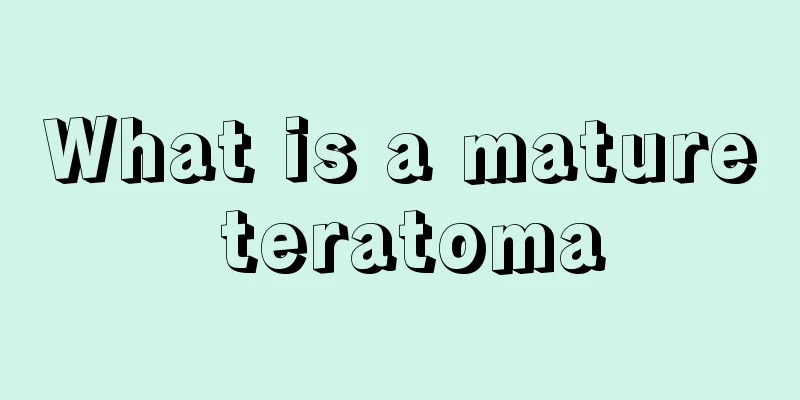What is a mature teratoma

|
What is a mature teratoma? Teratomas can occur in the central nervous system, but they are relatively rare. If such tumors are small or non-functional, they usually have no specific clinical manifestations. Teratomas in the spinal canal are often accompanied by various nerve compression symptoms. Let's introduce what a mature teratoma is. Mature teratoma is a benign teratoma, which comes in two types: cystic and solid. 1. Mature cystic teratoma is a benign cystic teratoma. This tumor is mostly composed of skin appendages of ectoderm origin and is also called dermoid cyst. It can occur in women of any age, from infants to elderly women. Gross examination: Most of them occur on one side, and less often on both sides. The size of the tumor varies, ranging from 0.3era to more than 45cm in diameter; more than half of them are 6 to 10cm in diameter, round or lobed, with a smooth surface, grayish white, and the cystic cavity is soft and elastic. Most of the cut surfaces are unilocular, and a few are multilocular, filled with a mixture of yellow greasy substances, keratinized substances and hair; the cyst walls are relatively smooth, and a solid area protrudes into the cystic cavity at a certain point, which is grayish white and often has hair, called the "head knot", which is as small as a bean or as large as a child's head. The "head knot" is often fat, bone, and cartilage, and one or several intact teeth and irregular bone pieces or well-developed bones can be seen. Occasionally, organ-like structures such as parts of the intestine, trachea, and even fetal limbs can be seen. Light microscopic examination: the cyst wall is lined with various mature epithelia, including squamous epithelium, sebaceous glands, sweat glands, and hair; mature bone, cartilage, brain tissue, glial tissue, retina, choroid, ganglion, etc., as well as foreign body giant cell reaction. 2. Mature solid teratoma is rare. The tumor is grayish white with a smooth surface, mainly solid, with small cysts formed in between, and is composed of various mature tissues from three germ layers. It is necessary to obtain sufficient tissue to exclude immature components. 3. Fetal teratoma is rare, with only fetal-like components in the teratoma. Hydrocephalus, toes, feet, eyes, teeth, penis, etc. can be seen. This type of teratoma must be distinguished from parasitic fetuses and old ectopic pregnancies in the fetus. 4. Malignant transformation of mature teratoma Any component of mature cystic teratoma can become malignant, with a malignancy rate of 2% to 4%. It mostly occurs in postmenopausal women, with an average age of 50.6 years old, and most of them are squamous cell carcinomas, while adenocarcinomas, sarcomas, and carcinosarcomas are less common. Gross examination: The tumor is larger than mature cystic teratoma, with an average diameter of 11 cm, grayish white, shiny, and smooth. If the malignant components of the tumor infiltrate and penetrate the capsule, they often adhere to the surrounding tissues and organs. Malignant changes are mostly in the head knot area, at which time the head knot becomes rough, mushroom-shaped or cauliflower-shaped, and the tissue is brittle; when it grows rapidly, the malignant tissue can fill the entire cyst cavity and can be easily mistaken for an immature teratoma. More tissues must be taken to find the remains of the original cyst cavity. The malignant transformation of mature teratoma is more common in epithelial components. Light microscopic examination: squamous cell carcinoma is the most common, about 90%. If the malignant transformation is limited to the epithelial layer, it is like general squamous cell carcinoma in situ, but invasive carcinoma is the most common, with different degrees of differentiation, and high differentiation accounts for about 1/2. In addition, there may be rare adenocarcinoma, sarcoma, carcinosarcoma and extremely rare malignant melanoma, carcinoid, neuroblastoma, and even rare extramammary Paget's disease. The probability of malignant transformation of all three germ layers is extremely low, and it needs to be distinguished from immature teratoma. The key point is that the malignant can have transitional lesions from mature tissue to cancerous tissue, while immature teratoma does not have transitional lesions, but it is difficult to distinguish in practice, especially when the range of malignant transformation is wide. |
<<: Can Traditional Chinese Medicine cure teratoma?
>>: What are the dietary requirements for teratoma
Recommend
Is it okay to wash your hair with soap?
Soap is a great detergent. If you use it to take ...
How to deal with termites at home
What people don’t know is that the termites that ...
What is the treatment for depression?
In real life, depression is a psychological disea...
Can you eat water-injected pork?
It is best not to eat water-injected pork. Long-t...
What are the functions and effects of yellow agate?
I believe most people have heard of agate in thei...
Postoperative care after laryngeal cancer resection
What are the postoperative care for laryngeal can...
How long can you live with an ovarian tumor?
Ovarian tumors are the cause of many female frien...
Is colon cancer serious? Can colon cancer be cured?
Colon cancer is a type of malignant tumor. If not...
How to treat phv
Genital warts are relatively common in our daily ...
How long can patients with advanced nasopharyngeal carcinoma live
The survival time of patients with advanced nasop...
How long can you live with stage 4 prostate cancer
Basically, if most patients have stage 4 prostate...
What are the local symptoms of lung cancer? Will bullae turn into lung cancer?
Lung cancer is an internal medicine disease that ...
What are the dangers of nasopharyngeal cancer
In life, the health hazards brought by nasopharyn...
Are the sequelae of bone cancer serious?
For patients with bone cancer, active treatment i...
White spots on the body
No matter who you are, you can quickly notice any...









